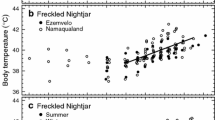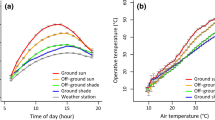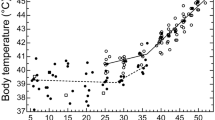Abstract
Hot, dry summer conditions impose physiological stress on endotherms, yet we have a poor understanding of how endotherms seasonally adjust their costs of thermoregulation under hot conditions. We determined whether seasonal phenotypic plasticity in evaporative cooling capacity at high temperatures explained how the range-restricted Cape Rockjumper (Chaetops frenatus; hereafter ‘Rockjumper’), copes with hot and dry summer temperatures of the temperate mountain peaks of southwest South Africa. We measured evaporative water loss (EWL), resting metabolic rate (RMR), and body temperature at high air temperatures (30–42 °C) of individuals from a wild population of Rockjumpers during winter and summer (n = 11 winter, 4 females, 7 males; n = 10 summer, 6 females, 4 males). We found Rockjumper evaporative cooling in summer imposes higher EWL (i.e. greater water costs) compared to winter, although an accompanying lack of change in RMR resulted in increased summer cooling efficiency. These patterns are similar to those observed in species that inhabit regions where summer temperatures are routinely high but the species are not water stressed. Our findings indicate that avian seasonal physiological adjustments to heat can be diverse. Further seasonal studies on thermoregulation in response to heat will greatly improve our knowledge of the functional value of traits such as evaporative cooling efficiency and heat tolerance and how they contribute to the physiological stress organisms experience in heterogenous environments.
Zusammenfassung
Saisonale physiologische Reaktionen auf Hitze bei einer alpinen Vogelart mit begrenztem Verbreitungsgebiet: der Kapfelsenspringer ( Chaetops frenatus )
Heiße und trockene Bedingungen im Sommer bewirken physiologischen Stress bei warmblütigen Tieren. Dennoch haben wir ein begrenztes Verständnis, wie Endotherme die Kosten für die Thermoregulation unter Hitzebedingungen saisonal anpassen. Wir bestimmten, inwiefern die saisonale phänotypische Plastizität in der Fähigkeit zur Verdunstungskühlung bei hohen Temperaturen erklärt, wie die in ihrem Verbreitungsgebiet begrenzten Kapfelsenspringer (Chaetops frenatus) mit den heißen und trockenen Sommertemperaturen der gemäßigten Berggipfel im südwestlichen Südafrika zurechtkommen. Gemessen wurden der Wasserverlust durch Verdunsten, der Ruhestoffwechsel sowie die Körpertemperatur bei hohen Lufttemperaturen (30-42 °C) von Individuen einer Population von Kapfelsenspringern im Winter und im Sommer (n = 11 Winter, 4 Weibchen, 7 Männchen; n = 10 Sommer, 6 Weibchen, 4 Männchen). Wir stellten fest, dass die Verdunstungskühlung im Sommer einen höheren Wasserverlust (und damit höheren Wasserbedarf) im Vergleich zum Winter bedingt. Wenngleich eine damit einhergehende fehlende Veränderung im Ruhestoffwechsel in einer gesteigerten Kühleffektivität im Sommer resultiert. Diese Muster sind vergleichbar mit denen von Arten, die Regionen mit üblicherweise hohen Sommertemperaturen, aber ohne Wasserstress besiedeln. Unsere Ergebnisse zeigen, dass saisonale physiologische Anpassungsstrategien an Hitze bei Vögeln sehr divers sein können. Weitere saisonale Studien zu Thermoregulation bei Hitze würden die Kenntnisse über die funktionalen Eigenschaften wie zum Beispiel die Effizienz der Verdunstungskühlung und Hitzetoleranz deutlich erweitern und Informationen darüber liefern, wie diese Eigenschaften zum physiologischen Stress von Organismen in einer heterogenen Umwelt betragen.




Similar content being viewed by others
References
Adolph SC (1990) Influence of behavioral thermoregulation on microhabitat use by two Sceloporus lizards. Ecology 71:315–327
Baker WC, Pouchot JF (1983) The measurement of gas flow. Part II. J Air Pollut Control Assoc 33:156–162
Barton K (2018) MuMIn: multi-model inference. R package version 1.40.4. https://CRAN.R-project.org/package=MuMIn
Bates D, Maechler M, Bolker B, Walker S (2015) Fitting linear mixed-effects models using ime4. J Stat Softw 67(1):1–48. https://doi.org/10.18637/jss.v067.i01
Boyles JG, Seebacher F, Smit B, McKechnie AE (2011) Adaptive thermoregulation in endotherms may alter responses to climate change. Integr Comp Biol 51:676–690
Buckley LB, Ehrenberger JC, Angilletta MJ (2015) Thermoregulatory behavior limits local adaptation of thermal niches and confers sensitivity to climate change. Funct Ecol 29:1038–1047
Clauser AJ, McRae SB (2017) Plasticity in incubation behavior and shading by King Rails Rallus elegans in response to temperature. J Avian Biol 48:479–488
Cooper SJ (2002) Seasonal metabolic acclimatization in Mountain Chickadees and Juniper Titmice. Physiol Biochem Zool 75:386–395
Cowling RM et al (2015) Variation in plant diversity in Mediterranean-climate ecosystems: the role of climatic and topographical stability. J Biogeogr 42:552–564
Cunningham SJ, Martin RO, Hockey PA (2015) Can behaviour buffer the impacts of climate change on an arid-zone bird? Ostrich 86:1–8
Fox J et al (2011) The car package
Gerson AR, Smith EK, Smit B, McKechnie AE, Wolf BO (2014) The impact of humidity on evaporative cooling in small desert birds exposed to high air temperatures. Physiol Biochem Zool 87:782–795
Holmes RT, Frauenknecht BD, Du Plessis MA (2002) Breeding system of the Cape Rockjumper, a South African fynbos endemic. Condor 104:188–192
Kearney MR, Porter WP, Murphy SA (2016) An estimate of the water budget for the endangered Night Parrot of Australia under recent and future climates. Clim Change Responses 3:14
Lee AT, Barnard P (2016) Endemic birds of the Fynbos Biome: a conservation assessment and impacts of climate change. Bird Conserv Int 26:52–68
Lighton JR (2008) Measuring metabolic rates: a manual for scientists. Oxford University Press, Oxford
Maloney SK, Dawson TJ (1998) Changes in pattern of heat loss at high ambient temperature caused by water deprivation in a large flightless bird, the Emu. Physiol Zool 71:712–719
Marder J, Arieli Y (1988) Heat balance of acclimated pigeons (Columba livia) exposed to temperatures up to 60 °C Ta. Comp Biochem Physiol A Physiol 91:165–170
Marras S et al (2015) Predicting future thermal habitat suitability of competing native and invasive fish species: from metabolic scope to oceanographic modelling. Conserv Physiol 3:cou059
McKechnie AE, Wolf BO (2004) Partitioning of evaporative water loss in White-winged Doves: plasticity in response to short-term thermal acclimation. J Exp Biol 207:203–210
McKechnie AE, Noakes MJ, Smit B (2015) Global patterns of seasonal acclimatization in avian resting metabolic rates. J Ornithol 156:367–376
McKechnie AE et al (2016) Avian thermoregulation in the heat: efficient evaporative cooling allows for extreme heat tolerance in four Southern Hemisphere columbids. J Exp Biol 219:2145–2155
Milne R, Cunningham SJ, Lee AT, Smit B (2015) The role of thermal physiology in recent declines of birds in a biodiversity hotspot. Conserv Physiol 3:cov048
Mucina L, Rutherford MC (2006) The vegetation of South Africa, Lesotho and Swaziland. South African National Biodiversity Institute, Pretoria
Muggeo VM (2003) Estimating regression models with unknown break-points. Stat Med 22:3055–3071
Noakes MJ, Wolf BO, McKechnie AE (2016) Seasonal and geographical variation in heat tolerance and evaporative cooling capacity in a passerine bird. J Exp Biol 219:859–869
O’Connor RS, Wolf BO, Brigham RM, McKechnie AE (2016) Avian thermoregulation in the heat: efficient evaporative cooling in two southern African Nightjars. J Comp Physiol B 187:477–491
Ophir E, Arieli Y, Marder J, Horowitz M (2002) Cutaneous blood flow in the pigeon Columba livia: its possible relevance to cutaneous water evaporation. J Exp Biol 205:2627–2636
Oswald KN, Evlambiou AA, Ribeiro ÂM, Smit B (2018) Tag location and risk assessment for PIT-tagging passerines. Ibis 160:453–457
Prinzinger R, Pressmar A, Schleucher E (1991) Body temperature in birds. Comp Biochem Physiol A Physiol 99:499–506
R Core Team (2017) R: a language and environment for statistical computing. R Foundation for Statistical Computing, Vienna, Austria 2016, pp 860–864
Ratnayake CP, Morosinotto C, Ruuskanen S, Villers A, Thomson RL (2014) Passive integrated transponders (PIT) on a small migratory passerine bird: absence of deleterious short and long-term effects. Ornis Fenn 91:244–255
Smit B, McKechnie AE (2015) Water and energy fluxes during summer in an arid-zone passerine bird. Ibis 157:774–786
Smit B, Harding CT, Hockey PAR, McKechnie AE (2013) Adaptive thermoregulation during summer in two populations of an arid-zone passerine. Ecology 94:1142–1154
Swanson DL (1991) Seasonal adjustments in metabolism and insulation in the Dark-eyed Junco. Condor 93:538–545
Swanson DL (2010) Seasonal metabolic variation in birds: functional and mechanistic correlates. Curr Ornithol 17:75–129
Tieleman BI (2002) Avian adaptation along an aridity gradient: physiology, behavior, and life history. University of Groningen
Tieleman BI, Williams JB (1999) The role of hyperthermia in the water economy of desert birds. Physiol Biochem Zool 72:87–100
Tieleman BI, Williams JB (2002) Cutaneous and respiratory water loss in larks from arid and mesic environments. Physiol Biochem Zool 75:590–599
Tieleman BI, Williams JB, Buschur ME (2002a) Physiological adjustments to arid and mesic environments in larks (Alaudidae). Physiol Biochem Zool 75:305–313
Tieleman BI, Williams JB, LaCroix F, Paillat P (2002b) Physiological responses of Houbara Bustards to high ambient temperatures. J Exp Biol 205:503–511
Walsberg G, Wolf B (1995) Variation in the respiratory quotient of birds and implications for indirect calorimetry using measurements of carbon dioxide production. J Exp Biol 198:213–219
Whitfield MC, Smit B, McKechnie AE, Wolf BO (2015) Avian thermoregulation in the heat: scaling of heat tolerance and evaporative cooling capacity in three southern African arid-zone passerines. J Exp Biol 218:1705–1714
Williams JB, Tieleman BI (2000) Flexibility in basal metabolic rate and evaporative water loss among Hoopoe Larks exposed to different environmental temperatures. J Exp Biol 203:3153–3159
Williams JB, Tieleman BI (2005) Physiological adaptation in desert birds. Bioscience 55:416–425
Wolf B (2000) Global warming and avian occupancy of hot deserts; a physiological and behavioral perspective. Rev Chil Hist Nat Natural 73:395–400
Woolbright SA, Whitham TG, Gehring CA, Allan GJ, Bailey JK (2014) Climate relicts and their associated communities as natural ecology and evolution laboratories. Trends Ecol Evol 29:406–416
Zuur AF, Ieno EN, Elphick CS (2010) A protocol for data exploration to avoid common statistical problems. Methods Ecol Evol 1:3–14
Acknowledgements
We firstly thank the Lee family for allowing us to conduct research on their property. We would also like to thank A. E. McKechnie for lending us the RH-300 water vapour analyser for the duration of the study. We are indebted to the many volunteers who spent hours and days helping us to catch Rockjumpers: Audrey Miller, Jenny Tartini, Alacia Welch, Gavin Emmons, Cristina Ebneter, Nicolas Pattinson, Cuen Muller, and Maxine Smit. Special thanks to Mark Brigham and two anonymous reviewers for commenting on drafts of this manuscript. This study was funded by a National Research Foundation (S. A.)-Thuthuka Grant (B. S.) and a Nelson Mandela Metropolitan University Research Themes Grant (B. S.). All experimental procedures were approved by the Research Ethics Committee: Animal (A15-SCI-ZOO-007) at Nelson Mandela Metropolitan University with a bird capture permit issued by Cape Nature, Western Cape, South Africa (0037-AAA041-00060).
Author information
Authors and Affiliations
Corresponding author
Additional information
Communicated by L. Fusani.
Electronic supplementary material
Below is the link to the electronic supplementary material.
Rights and permissions
About this article
Cite this article
Oswald, K.N., Lee, A.T.K. & Smit, B. Seasonal physiological responses to heat in an alpine range-restricted bird: the Cape Rockjumper (Chaetops frenatus). J Ornithol 159, 1063–1072 (2018). https://doi.org/10.1007/s10336-018-1582-8
Received:
Revised:
Accepted:
Published:
Issue Date:
DOI: https://doi.org/10.1007/s10336-018-1582-8




